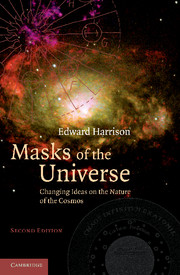Book contents
- Frontmatter
- Contents
- Prefece
- 1 Introducing the Masks
- Part I Worlds in the Making
- Part II The Heart Divine
- 8 Dance of the Atoms and Waves
- 9 Fabric of Space and Time
- 10 What Then is Time?
- 11 Nearer to the Heart's Desire
- 12 The Cosmic Tide
- 13 Do Dreams Come True?
- Part III The Cloud of Unknowing
- Bibliography
- Index
12 - The Cosmic Tide
Published online by Cambridge University Press: 27 October 2009
- Frontmatter
- Contents
- Prefece
- 1 Introducing the Masks
- Part I Worlds in the Making
- Part II The Heart Divine
- 8 Dance of the Atoms and Waves
- 9 Fabric of Space and Time
- 10 What Then is Time?
- 11 Nearer to the Heart's Desire
- 12 The Cosmic Tide
- 13 Do Dreams Come True?
- Part III The Cloud of Unknowing
- Bibliography
- Index
Summary
We live in the Solar System on the planet Earth that revolves with other planets around a star called the Sun. Light from the Sun hurrying at great speed takes 500 seconds to reach the Earth and five hours to reach the far-flung planet Pluto. The Earth that to us seems large is dwarfed by the Solar System with its whirling planets.
Starlight from the nearest stars travels for years before reaching the Earth. If we imagine the Sun having the size of a grain of sand, the nearby stars on the same scale would be at a distance of one hour's drive on an interstate highway. Scattered out to enormous distances in all directions are a hundred billion stars that constitute the whirlpool system called our Galaxy. The Galaxy – a glittering carousel of stars across which light takes 100,000 years to travel and around which the Sun journeys once every 200 million years – seems incomprehensibly large compared with the solar system.
Much has been discovered about the Galaxy: its many kinds of stars, sunlike stars, blue, yellow, and red giants, binary stars, white dwarfs, and dense neutron stars; its great spiral disk seen by us as the Milky Way where clouds of glowing gas and obscuring dust give birth to new stars; its even greater halo of very old stars and globular clusters; and still much that remains to be discovered.
Newton's universe of uniformly distributed stars has become Wright's universe.
- Type
- Chapter
- Information
- Masks of the UniverseChanging Ideas on the Nature of the Cosmos, pp. 193 - 212Publisher: Cambridge University PressPrint publication year: 2003

